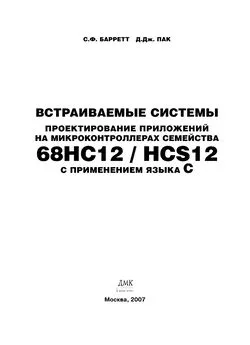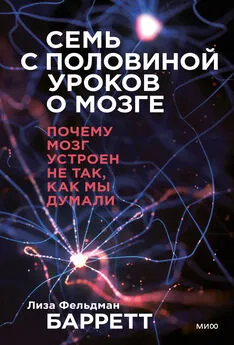Лиза Барретт - Как рождаются эмоции
- Название:Как рождаются эмоции
- Автор:
- Жанр:
- Издательство:Манн, Иванов и Фербер
- Год:2018
- Город:Москва
- ISBN:нет данных
- Рейтинг:
- Избранное:Добавить в избранное
-
Отзывы:
-
Ваша оценка:
Лиза Барретт - Как рождаются эмоции краткое содержание
Эта книга совершает революцию в понимании эмоций, разума и мозга. Вас ждет захватывающее путешествие по удивительным маршрутам, с помощью которых мозг создает вашу эмоциональную жизнь. Вы научитесь по-новому смотреть на эмоции, свои взаимоотношения с людьми и в конечном счете на самих себя. На русском языке публикуется впервые.
Как рождаются эмоции - читать онлайн бесплатно ознакомительный отрывок
Интервал:
Закладка:
Crum, Alia J., Peter Salovey, and Shawn Achor. 2013. “Rethinking Stress: The Role of Mindsets in Determining the Stress Response.” Journal of Personality and Social Psychology 104 (4): 716–733.
Curry, John, Susan Silva, Paul Rohde, Golda Ginsburg, Christopher Kratochvil, Anne Simons, Jerry Kirchner, Diane May, Betsy Kennard, and Taryn Mayes. 2011. “Recovery and Recurrence Following Treatment for Adolescent Major Depression.” Archives of General Psychiatry 68 (3): 263–269.
Damasio, Antonio. 1994. Descartes’ Error: Emotion, Reason and the Human Brain . New York: Avon.
——— . 1999. The Feeling of What Happens: Body and Emotion in the Making of Consciousness . New York: Harcourt Brace & Company.
Damasio, Antonio, and Gil B. Carvalho. 2013. “The Nature of Feelings: Evolutionary and Neurobiological Origins.” Nature Reviews Neuroscience 14 (2): 143–152.
Danese, Andrea, and Bruce S. McEwen. 2012. “Adverse Childhood Experiences, Allostasis, Allostatic Load, and Age-Related Disease.” Physiology and Behavior 106 (1): 29–39.
Dannlowski, Udo, Anja Stuhrmann, Victoria Beutelmann, Peter Zwanzger, Thomas Lenzen, Dominik Grotegerd, Katharina Domschke, Christa Hohoff, Patricia Ohrmann, and Jochen Bauer. 2012. “Limbic Scars: Long-Term Consequences of Childhood Maltreatment Revealed by Functional and Structural Magnetic Resonance Imaging.” Biological Psychiatry 71 (4): 286–293.
Dantzer, Robert, Cobi Johanna Heijnen, Annemieke Kavelaars, Sophie Laye, and Lucile Capuron. 2014. “The Neuroimmune Basis of Fatigue.” Trends in Neurosciences 37 (1): 39–46.
Dantzer, Robert, Jan-Pieter Konsman, Rose-Marie Bluthé, and Keith W. Kelley. 2000. “Neural and Humoral Pathways of Communication from the Immune System to the Brain: Parallel or Convergent?” Autonomic Neuroscience 85 (1): 60–65.
Danziger, Kurt. 1997. Naming the Mind: How Psychology Found Its Language . London: Sage.
Danziger, Shai, Jonathan Levav, and Liora Avnaim-Pesso. 2011. “Extraneous Factors in Judicial Decisions.” Proceedings of the National Academy of Sciences 108 (17): 6889–6892.
Darwin, Charles. (1859) 2003. On the Origin of Species . Facsimile edition. Cambridge, MA: Harvard University Press.
——— . (1871) 2004. The Descent of Man, and Selection in Relation to Sex . London: Penguin Classics.
——— . (1872) 2005. The Expression of the Emotions in Man and Animals . Stilwell, KS: Digireads.com.
Dashiell, John F. 1927. “A New Method of Measuring Reactions to Facial Expression of Emotion.” Psychological Bulletin 24: 174–175.
De Boer, Sietse F., and Jaap M. Koolhaas. 2003. “Defensive Burying in Rodents: Ethology, Neurobiology and Psychopharmacology.” European Journal of Pharmacology 463 (1): 145–161.
Deffenbacher, Kenneth A., Brian H. Bornstein, Steven D. Penrod, and E. Kiernan McGorty. 2004. “A Meta-Analytic Review of the Effects of High Stress on Eyewitness Memory.” Law and Human Behavior 28 (6): 687–706.
De Leersnyder, Jozefien, Batja Mesquita, and Heejung S. Kim. 2011. “Where Do My Emotions Belong? A Study of Immigrants’ Emotional Acculturation.” Personality and Social Psychology Bulletin 37 (4): 451–463.
Demiralp, Emre, Renee J. Thompson, Jutta Mata, Susanne M. Jaeggi, Martin Buschkuehl, Lisa Feldman Barrett, Phoebe C. Ellsworth, Metin Demiralp, Luis Hernandez-Garcia, and Patricia J. Deldin. 2012. “Feeling Blue or Turquoise? Emotional Differentiation in Major Depressive Disorder.” Psychological Science 23 (11): 1410–1416.
Deneve, Sophie, and Renaud Jardri. 2016. “Circular Inference: Mistaken Belief, Misplaced Trust.” Current Opinion in Behavioral Sciences 11: 40–48.
Denham, Joshua, Brendan J. O’Brien, and Fadi J. Charchar. 2016. “Telomere Length Maintenance and Cardio-Metabolic Disease Prevention Through Exercise Training.” Sports Medicine , February 25, 1–25.
Denham, Susanne A. 1998. Emotional Development in Young Children . New York: Guilford Press.
Denison, Stephanie, Christie Reed, and Fei Xu. 2013. “The Emergence of Probabilistic Reasoning in Very Young Infants: Evidence from 4.5- and 6-Month-Olds.” Developmental Psychology 49 (2): 243–249.
Denison, Stephanie, and Fei Xu. 2010. “Twelve- to 14-Month-Old Infants Can Predict Single-Event Probability with Large Set Sizes.” Developmental Science 13 (5): 798–803.
——— . 2014. “The Origins of Probabilistic Inference in Human Infants.” Cognition 130 (3): 335–347.
“Developments in the Law: Legal Responses to Domestic Violence.” 1993. Harvard Law Review 106 (7): 1498–1620.
Dixon-Gordon, Katherine L., Alexander L. Chapman, Nicole H. Weiss, and M. Zachary Rosenthal. 2014. “A Preliminary Examination of the Role of Emotion Differentiation in the Relationship Between Borderline Personality and Urges for Maladaptive Behaviors.” Journal of Psychopathology and Behavioral Assessment 36 (4): 616–625.
Donoghue, Philip C. J., and Mark A. Purnell. 2005. “Genome Duplication, Extinction and Vertebrate Evolution.” Trends in Ecology and Evolution 20 (6): 312–319.
Dowlati, Yekta, Nathan Herrmann, Walter Swardfager, Helena Liu, Lauren Sham, Elyse K. Reim, and Krista L. Lanctôt. 2010. “A Meta-Analysis of Cytokines in Major Depression.” Biological Psychiatry 67 (5): 446–457.
Dreger, Alice Domurat. 1998. Hermaphrodites and the Medical Invention of Sex . Cambridge, MA: Harvard University Press.
——— . 2015. Galileo’s Middle Finger: Heretics, Activists, and the Search for Justice in Science , New York: Penguin.
Dreger, Alice D., Cheryl Chase, Aron Sousa, Philip A. Gruppuso, and Joel Frader. 2005. “Changing the Nomenclature/Taxonomy for Intersex: A Scientific and Clinical Rationale.” Journal of Pediatric Endocrinology and Metabolism 18 (8): 729–734.
Dreyfus, Georges, and Evan Thompson. 2007. “Asian Perspectives: Indian Theories of Mind.” In The Cambridge Handbook of Consciousness , edited by Philip David Zelazo, Morris Moscovitch, and Evan Thompson, 89–114. New York: Cambridge University Press.
Drnevich, J., et al. 2012. “Impact of Experience-Dependent and Independent Factors on Gene Expression in Songbird Brain.” Proceedings of the National Academy of Sciences of the United States of America 109: 17245–17252.
Dubois, Samuel, Bruno Rossion, Christine Schiltz, Jean-Michel Bodart, Christian Michel, Raymond Bruyer, and Marc Crommelinck. 1999. “Effect of Familiarity on the Processing of Human Faces.” Neuroimage 9 (3): 278–289.
Duffy, Elizabeth. 1934. “Emotion: An Example of the Need for Reorientation in Psychology.” Psychological Review 41 (2): 184–198.
——— . 1941. “An Explanation of ‘Emotional’ Phenomena Without the Use of the Concept ‘Emotion.’” Journal of General Psychology 25 (2): 283–293.
Dunfield, Kristen, Valerie A. Kuhlmeier, Laura O’Connell, and Elizabeth Kelley. 2011. “Examining the Diversity of Prosocial Behavior: Helping, Sharing, and Comforting in Infancy.” Infancy 16 (3): 227–247.
Dunn, Elizabeth W., Daniel T. Gilbert, and Timothy D. Wilson. 2011. “If Money Doesn’t Make You Happy, Then You Probably Aren’t Spending It Right.” Journal of Consumer Psychology 21 (2): 115–125.
Dunn, Elizabeth, and Michael Norton. 2013. Happy Money: The Science of Smarter Spending . New York: Simon and Schuster.
Dunsmore, Julie C., Pa Her, Amy G. Halberstadt, and Marie B. Perez-Rivera. 2009. “Parents’ Beliefs About Emotions and Children’s Recognition of Parents’ Emotions.” Journal of Nonverbal Behavior 33 (2): 121–140.
Durham, William H. 1991. Coevolution: Genes, Culture, and Human Diversity . Stanford, CA: Stanford University Press.
Edelman, Gerald M. 1987. Neural Darwinism: The Theory of Neuronal Group Selection . New York: Basic Books.
——— . 1990. The Remembered Present : A Biological Theory of Consciousness. New York: Basic Books.
Edelman, G. M., and J. A. Gally. 2001. “Degeneracy and Complexity in Biological Systems.” Proceedings of the National Academy of Sciences 98: 13763–13768.
Edelman, Gerald M., and Giulio Tononi. 2000. A Universe of Consciousness: How Matter Becomes Imagination . New York: Basic Books.
Edersheim, Judith G., Rebecca Weintraub Brendel, and Bruce H. Price. 2012. “Neuroimaging, Diminished Capacity and Mitigation.” In Neuroimaging in Forensic Psychiatry: From the Clinic to the Courtroom , edited by Joseph R. Simpson, 163–193. West Sussex, UK: Wiley-Blackwell.
Einstein, Albert, Leopold Infeld, and Banesh Hoffmann. 1938. “The Gravitational Equations and the Problem of Motion.” Annals of Mathematics 39 (1): 65–100.
Eisenberger, Naomi I. 2012. “The Pain of Social Disconnection: Examining the Shared Neural Underpinnings of Physical and Social Pain.” Nature Reviews Neuroscience 13 (6): 421–434.
Eisenberger, Naomi I., and Steve W. Cole. 2012. “Social Neuroscience and Health: Neurophysiological Mechanisms Linking Social Ties with Physical Health.” Nature Neuroscience 15 (5): 669–674.
Eisenberger, Naomi I., Tristen K. Inagaki, Nehjla M. Mashal, and Michael R. Irwin. 2010. “Inflammation and Social Experience: An Inflammatory Challenge Induces Feelings of Social Disconnection in Addition to Depressed Mood.” Brain, Behavior, and Immunity 24 (4): 558–563.
Ekkekakis, Panteleimon, Elaine A. Hargreaves, and Gaynor Parfitt. 2013. “Invited Guest Editorial: Envisioning the Next Fifty Years of Research on the Exercise-Affect Relationship.” Psychology of Sport and Exercise 14 (5): 751–758.
Ekman, Paul. 1992. “An Argument for Basic Emotions.” Cognition and Emotion 6: 169–200.
——— . 2007. Emotions Revealed: Recognizing Faces and Feelings to Improve Communication and Emotional Life . New York: Henry Holt.
Ekman, Paul, and Daniel Cordaro. 2011. “What Is Meant by Calling Emotions Basic.” Emotion Review 3 (4): 364–370.
Ekman, Paul, and Wallace V. Friesen. 1971. “Constants Across Cultures in the Face and Emotion.” Journal of Personality and Social Psychology 17 (2): 124–129.
——— . 1984. EM-FACS Coding Manual . San Francisco: Consulting Psychologists Press.
Ekman, Paul, Wallace V. Friesen, Maureen O’Sullivan, Anthony Chan, Irene Diacoyanni-Tarlatzis, Karl Heider, Rainer Krause, William Ayhan LeCompte, Tom Pitcairn, and Pio E. Ricci-Bitti. 1987. “Universals and Cultural Differences in the Judgments of Facial Expressions of Emotion.” Journal of Personality and Social Psychology 53 (4): 712–717.
Ekman, Paul, Robert W. Levenson, and Wallace V. Friesen. 1983. “Autonomic Nervous System Activity Distinguishes Among Emotions.” Science 221 (4616): 1208–1210.
Ekman, Paul, E. Richard Sorenson, and Wallace V. Friesen. 1969. “Pan-Cultural Elements in Facial Displays of Emotion.” Science 164 (3875): 86–88.
Elfenbein, Hillary Anger, and Nalini Ambady. 2002. “On the Universality and Cultural Specificity of Emotion Recognition: A Meta-Analysis.” Psychological Bulletin 128 (2): 203–235.
Ellingsen, Dan-Mikael, Johan Wessberg, Marie Eikemo, Jaquette Liljencrantz, Tor Endestad, Håkan Olausson, and Siri Leknes. 2013. “Placebo Improves Pleasure and Pain Through Opposite Modulation of Sensory Processing.” Proceedings of the National Academy of Sciences 110 (44): 17993–17998.
Читать дальшеИнтервал:
Закладка:










